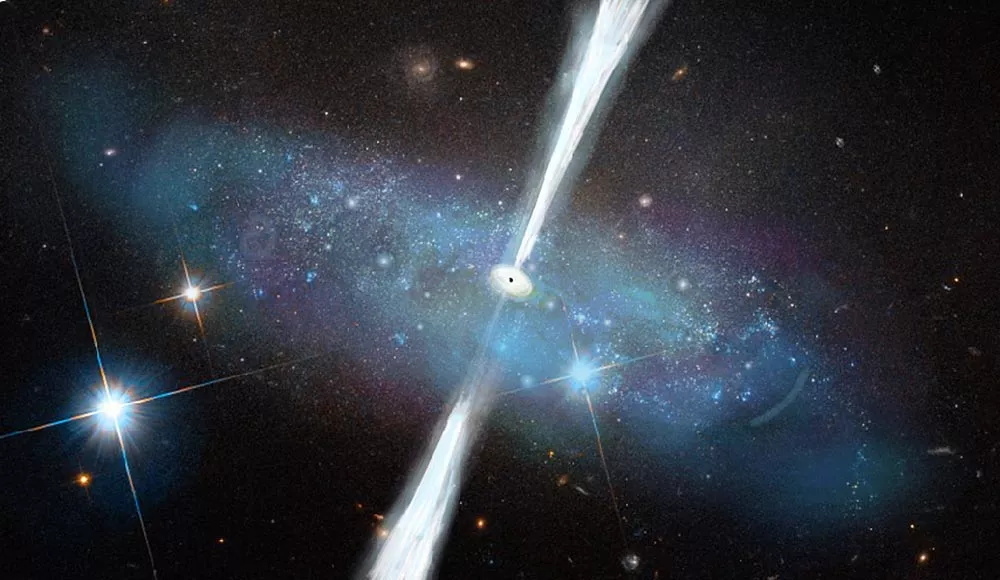The newly discovered black holes in dwarf galaxies reveal the origin of supermassive black holes in our Milky Way galaxy A research team led by astronomers from the Department of physics and astronomy at UNC Chapel Hill has discovered a previously neglected treasure house of massive black holes in dwarf galaxies These newly discovered black holes let people see the life story of the supermassive black hole in the center of our Milky Way galaxy.

Hide in full view
As a huge spiral galaxy, the Milky way is considered to be formed by the merger of many smaller dwarf galaxies. As seen in the southern sky, Magellanic Clouds are dwarf galaxies that will merge into the Milky way. Each falling dwarf star may bring a central supermassive black hole with a mass tens of thousands or hundreds of thousands of times that of our sun, and may be destined to be swallowed up by the central supermassive black hole of the Milky Way galaxy.
However, the frequency of dwarf galaxies containing a massive black hole is unknown, which leaves a key gap in our understanding of how black holes and galaxies grow together. A new study published in the Astrophysical Journal on May 24, 2022 helps fill this gap by revealing that massive black holes are many times more common in dwarf galaxies than previously thought.
"This result really surprised me because these black holes were previously hidden in full view," said mugdha polimera, the first author of the study and a doctoral student in the Department of physics and astronomy.
Send mixed messages
Black holes are usually detected when they actively grow by swallowing the surrounding gas and Stardust, which makes them emit strong light.
Professor Sheila kannappan, polimera's doctoral supervisor in the Department of physics and Astronomy and co-author of the research paper, compares black holes to fireflies. "Like fireflies, we can only see black holes when they are lit - when they are growing - and lit black holes give us a clue to how many black holes we can't see," he said
The problem is that when a growing black hole emits unique high-energy radiation, young newborn stars also glow. Traditionally, astronomers have used diagnostic tests to distinguish growing black holes from new star formation, which rely on the detailed characteristics of each galaxy's visible light in a spectrum scattered like a rainbow.
When undergraduates working with kannappan tried to apply these traditional tests to galaxy survey data, the road to discovery began. The team realized that some galaxies sent mixed messages - two tests showed that black holes were growing, but the third showed that only stars formed.
"Previous work has only rejected such ambiguities from statistical analysis, but I have a hunch that they may be undiscovered black holes in dwarf galaxies. She suspects that the third sometimes contradictory test is more sensitive to the typical characteristics of dwarf stars than the other two: their simple elemental composition (mainly primitive hydrogen and helium from the big Bang) and their high rate of formation of new stars," kannappan said
Chris Richardson, co-author of the research paper and associate professor of Elon University, confirmed through theoretical simulation that the mixed information test results are completely consistent with the theoretical prediction that the primitive composition and highly star forming dwarf galaxy contains a growing massive black hole. "My simulation results are consistent with the findings of kannappan's team, which makes me excited to explore the impact on how galaxies evolve."
Census of growing black holes
Polimera accepted the challenge of building a new growing black hole census and focused on traditional and mixed information types. She obtained published measurements of visible spectral characteristics to test the black holes of thousands of galaxies found in two surveys led by kannappan, resolve and eco. These surveys, including ultraviolet and radio data, are ideal for studying star formation, and they have an unusual design. Most astronomical surveys choose samples in favor of large and bright galaxies, while resolve and eco are a complete inventory of the huge volume of today's universe, with a large number of dwarf galaxies.
"It's important for me that our black hole search is not biased towards dwarf galaxies. But when I looked at the whole census, I found that new types of growth black holes almost always appear in dwarf stars. When I first saw these numbers, I was shocked," polimera said
It is reported that more than 80% of all the growing black holes she found in dwarf galaxies belong to new types.
The result seems too good. Polimera said: "we are all nervous. The first question that comes to mind is, have we missed a way to explain these galaxies simply by extreme star formation?" It is reported that she led a detailed search for alternative explanations involving star formation, modeling uncertainty or exotic astrophysics. Finally, the team was forced to conclude that the newly discovered black hole was real.